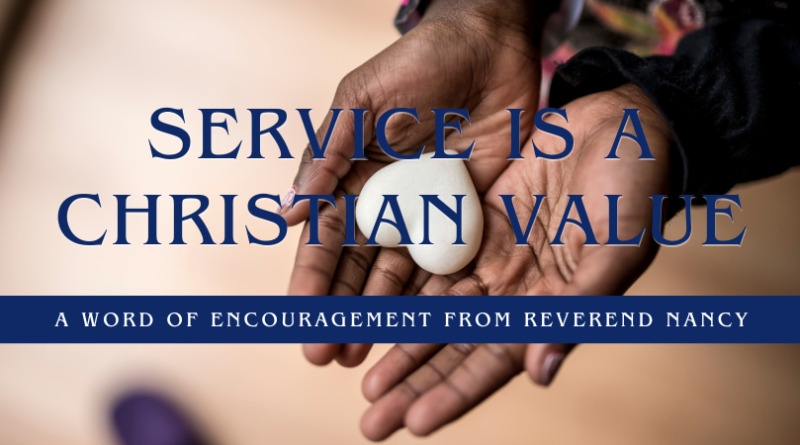Service is a Christian value
If you love those who love you, what credit is that to you? For even sinners love those who love them. If you do good to those who do good to you, what credit is that to you? For even sinners do the same. (Luke 6:32-34 NRSV)
Jesus poses tough questions and challenges his followers to be different. It is not enough to care for those closest to you, or those in a position to assist you, Jesus insists. Those who follow him will be asked to reach beyond their own friends and family to tend those in need: physically, spiritually, and emotionally.
In the ancient world, this led Saint Paul to gather financial resources from churches in what is now Syria, Greece, and Turkey to assist those in need in Jerusalem. Since then, Christians have built hospitals, schools, orphanages, and shelters of many kinds. This type of caring for neighbors we never will meet is understood as the core of living out Jesus’ call to bring good news and to be good news.
In the early fall of 1793, the city of Philadelphia was the capital of the state of Pennsylvania and the new United States of America, the largest of American cities and commercial, political, and economic center of the young country. It was also in the throes of a yellow fever epidemic, the first to hit this fledgling country. No one knew why people were being infected, nor how to treat the disease once it was contracted. Fear, rumors, and the breakdown of social order prompted half the population to leave, including the governor and President George Washington. (It would be a century before Walter Reed in 1900 would determine how the disease was spread through the bite of infected mosquitos.) By the time the epidemic ended in late October (when frost killed the mosquitoes), approximately 5,000 people had died, ten percent of Philadelphia’s pre-epidemic population.
As the pandemic ravaged the city, the mayor convened a board of citizen volunteers to run the city. He asked Absalom Jones and Richard Allen, black men who had been born in slavery and later bought their freedom, for their assistance. The mayor’s request was prompted by the prevailing (and erroneous) medical theory that African Americans were naturally immune to yellow fever. (The reality, unknown at the time, was that some enslaved people who were born in Africa had immunity because they’d already been exposed to the disease in their homelands and survived it. Those born in the United States did not have such immunity. During the epidemic, Absalom Jones and many black Philadelphians would contract the disease. Jones survived the disease, but many did not.)
At the time of the epidemic, Jones and Allen were leaders of the largest free Black community in the United States. They established Philadelphia’s Free African Society in 1787 to provide financial assistance, promote literacy, and advance the lives of black citizens. Jones and Allen had also greatly increased Black membership at St. George’s Methodist Episcopal Church where they were members. In 1791, White members alarmed by the rise in black attendance prompted the vestry to segregate African Americans into an upstairs gallery without notice. One Sunday when ushers attempted to remove the black congregants from their pews, they exited the church. Richard Allen subsequently established the African Methodist Episcopal Church (AME) while Absalom Jones founded the African Episcopal Church of St. Thomas. Jones was the first black person ordained to the priesthood in the Episcopal Church.
In responding to the yellow fever epidemic, Jones and Allen understood that assisting others was part of the Christian moral duty. Under their leadership, African Americans began to provide essential services: they nursed those who were ill, transported the sick, cleaned the streets, and buried the dead.
As a counter to the erroneous theory of black immunity, Allen and Jones co-authored a pamphlet outlining the effects of the disease on Black Philadelphians. Subsequent to the epidemic, Jones and Allen also published a protest pamphlet, “A Narrative of the Proceedings of the Black People, During the Late Awful Calamity in Philadelphia, in the Year 1793; and a Refutation of Some Censures, Thrown Upon Them in Some Late Publications.” Their work was a response to newspaper owner Mathew Carey’s assertion that African Americans profited from nursing the sick. (For his part, Carey had been on the mayor’s citizen board, but fled the city as the epidemic toll rose.) Jones and Allen refuted his accusations, decried the racist characterization of Black people in his work, broke the silence around racial prejudice in the city, and detailed the death and suffering of Black Philadelphians. Their work provided the only account of the epidemic from the perspective of Black citizens and became the first black publication to receive federal copyright.
Service is a Christian value; silence is not.

